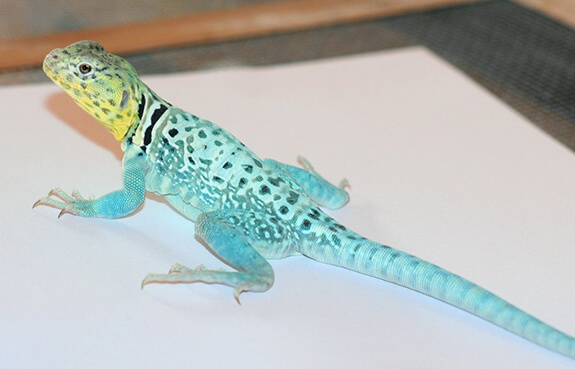Learn More About The True Lizard (Lacertidae) Family
Some genera of this family, to which the lizards described belong, are also called collared lizards. They are differentiated from other lizards by a horizontal fold between the throat and the chest scales. At the back end of this fold the scales are noticeably enlarged. True lizards are among those that are able to discard their tails to deceive a pursuer. A typical submissive gesture is treading.

Differences between the sexes: The males always have distinctly prominent femoral pores and a thicker tail base than the female.
Reproduction: While the male of the Canary Islands lizards bites the neck of the female during copulation, the male of the Pityuses lizards bites the flank. Up to three egg clutches are buried every year in a damp place in the ground. The eggs must be transferred to the incubator because only there can constant humidity be guaranteed.
Canary Islands lizard*
Gallotia galloti (Dumeril and Bibron, 1839)
Total length: 18 inches (45 cm). Head-torso length: 5 inches (12 cm).
Distribution and Description: Canary Islands; there are subspecies on individual islands. Habitat: Fields of scree, borders of cultivated land.
Identifying characteristics: Cleft tongue. Sexually mature males have blue spots on neck and flanks. Juvenile females have stripes.
Behavior: Diurnal. Lives in ground and rock falls. Males are sometimes very territorial.
Maintenance: Terrarium, 48 x 20 x 20 inches (120 x 50 x 50 cm), for one male and three females.
Decorations: Stones and lava, though not firmly fixed because they must be removable for cleaning. Sand with damp areas for egg-laying. Plants from the Canary Islands. Sunning places and UV lighting. Sun terrarium.
Temperature: By day exactly 77° to 95°F (25 – 35°C); by night 64°F (18°C). Pseudo-winter rest from November to February at 59° to 68°F (15 -20°C; reflector lamps not turned on).
Humidity: 50 to 70 percent.
Food: Insects are only occasionally eaten by young animals; otherwise worms, snails, baby mice, fruit, seeds, weeds (also dried), honey, rice, occasionally pudding and yogurt. Water will be licked from the decorations or from shallow saucers.
Pityuses lizard*
Podarcispityusensis (Bosca, 1883)
Endangered species regulation: WA II
Total length: 8 inches (20 cm). Head-torso length: 3 inches (7 cm).
Distribution and Description: Pityuses Islands: Ibiza, Formentera, and others, with subspecies on the particular islands.
Habitat: Fields of rockfall and sandy regions with sparse growth, stone fences, human dwellings.
Identifying characteristics: Typical lizard. Forked tongue.
Behavior: Diurnal. Lives in ground and among stones. Lives in colonies.
Maintenance: Terrarium 40 x 20 x 20 inches (100 x 50 X 50 cm), for six lizards.
Decoration: Sand, stones, rubble, and dry grass, well arranged. Plants of the Mediterranean area. Sunning spots and UV lighting. Sun terrarium.
Temperature: By day precisely 77° to 95° F (25 – 35°C); by night 64°F (18°C). During the months from December to February a winter rest at 46° to 57°F (8- 14°C); reflector lamps not turned on.
Humidity: 50 to 70 percent.
Food: Insects and spiders, fruit, weeds, honey, rice, yogurt and pudding. Drinking water will be licked from the decorations; spray plants with water once daily.



Leave a Reply